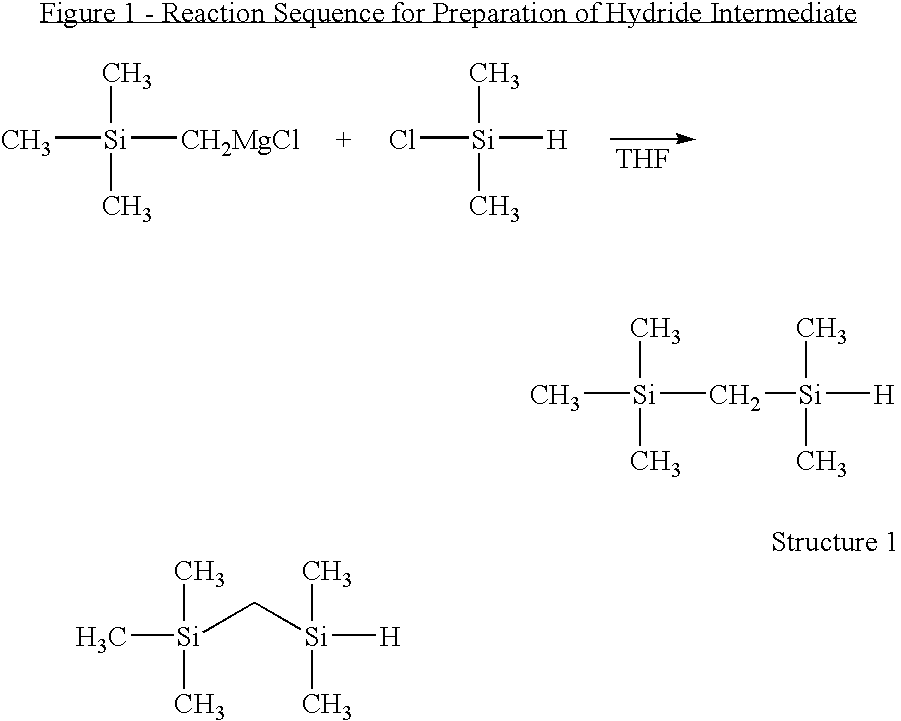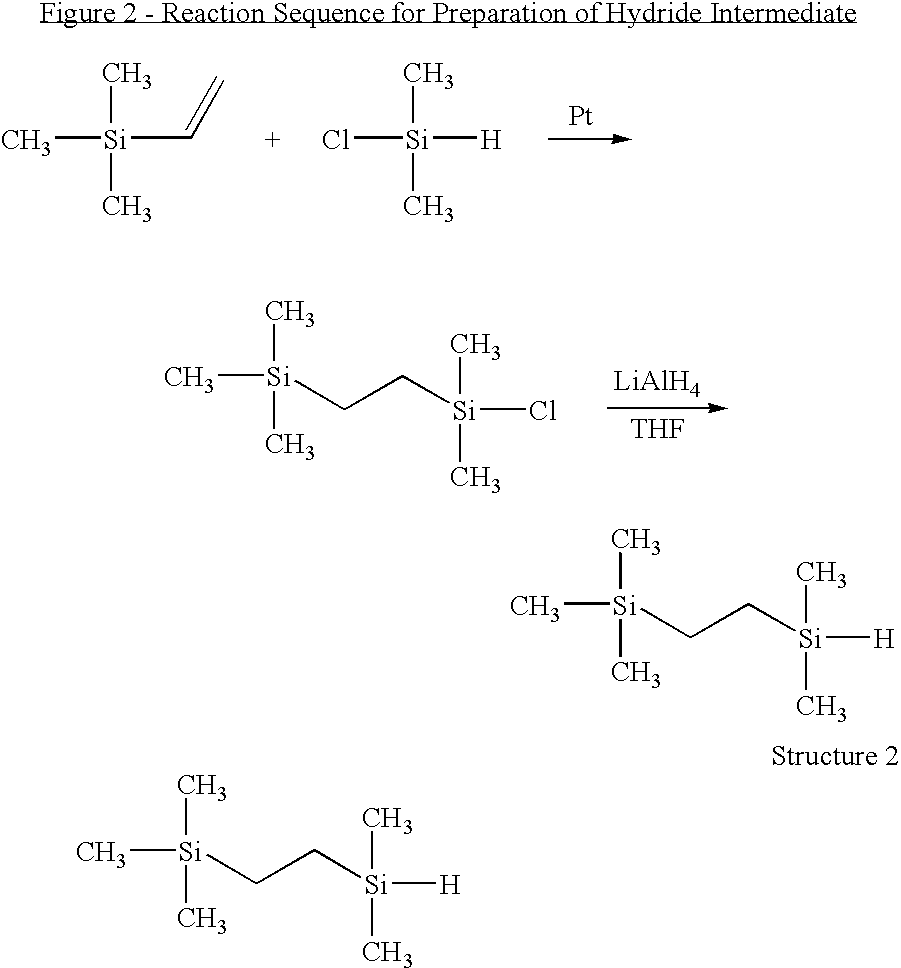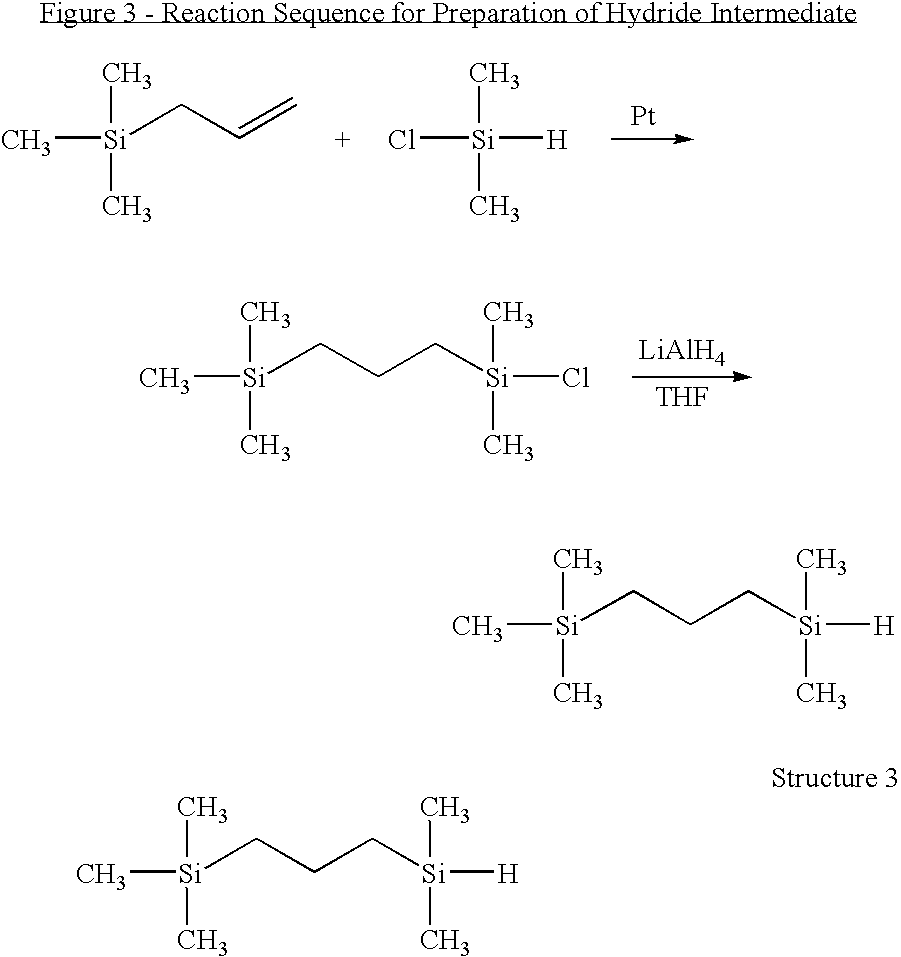Use of hydrolysis resistant organomodified silylated surfactants
a technology of organomodified silylated surfactants and hydrolysis resistance, which is applied in the direction of biocide, detergent compounding agents, hair cosmetics, etc., can solve the problem that the stability of trisiloxane compounds is not good for hydrolysis
- Summary
- Abstract
- Description
- Claims
- Application Information
AI Technical Summary
Benefits of technology
Problems solved by technology
Method used
Image
Examples
preparation example 1
(Trimethylsilylmethyl)dimethylsilane (FIG. 1, Structure 1)
[0065]The Grignard reagent of trimethylchloromethylsilane (TMCMS) was prepared by reaction of 12.3 g (0.1 mol) TMCMS and 2.88 g (0.12 mol) magnesium chips in THF (50 mL). The Grignard reagent was then added dropwise into 9.46 g (0.1 mol) dimethylchlorosilane (DMCS), which dissolved in THF (50 mL). The mixture was stirred at room temperature overnight and quenched with 20 mL HCl-acidified water, and then extracted with diethylether (100 mL). The organic layer washed with distilled water three times and dried with anhydrous sodium sulfate. The mixture was purified by distillation at 118-119° C. to yield 13.0 g (89%) (trimethylsilylmethyl)dimethylsilane product as a clear, colorless fluid.
preparation example 2
((2-Trimethylsilyl)ethyl)dimethylsilane (FIG. 2, Structure 2)
[0066]10 g (0.1 mol) trimethylvinylsilane (TMVS), 9.46 g (0.1 mol) dimethylchlorosilane (DMCS) and 10 μl platinum(0)-1,3-divinyl-1,1,3,3-tetramethyldisiloxane complex (0.1 M in xylene) were placed into a 100 mL three-necked round bottom flask equipped with N2 inlet and reflux condenser. The mixture was stirred at room temperature for 30 min and heated to 70° C. for 2 h. The reaction was monitored by 1H NMR. After cooling down to room temperature, 50 mL of THF was introduced and the solution was cooled to −80° C. 1.00 g LiAlH4 was added to the solution and stirred until the mixture warmed up to room temperature. The mixture was further stirred at room temperature overnight. 10 mL of acidified water was added to quench the reaction, and the organic layer was separated, washed with water three times and dried over anhydrous sodium sulfate. The mixture was purified by distillation, and 12.7 g (yield 79.2%) product was collecte...
preparation example 3
((3-Trimethylsilyl)propyl)dimethylsilane (FIG. 3, Structure 3)
[0067]11.4 g (0.1 mol) trimethylallylsilane, 9.5 g (0.1 mol) dimethylchlorosilane (DMCS) and 10 μl platinum(0)-1,3-divinyl-1,1,3,3-tetramethyldisiloxane complex (0.1 M in xylene) were placed into a 100 mL three-necked round bottom flask equipped with N2 inlet and condenser. The mixture was stirred at room temperature for 30 min and heated to 70° C. for 2 h. The reaction was monitored by 1H NMR. After cooling down to room temperature, 50 mL of THF was introduced and the solution was cooled to −80° C. 1.00 g LiAlH4 was added to the solution and stirred until the mixture warmed up to room temperature. The mixture was further stirred at room temperature overnight. 10 mL of acidified water was added to quench the reaction, and the organic layer was separated, washed with water three times and dried over anhydrous sodium sulfate. The mixture was purified by vacuum distillation, and 12.3 g (yield 70.7%) product was collected at ...
PUM
| Property | Measurement | Unit |
|---|---|---|
| Fraction | aaaaa | aaaaa |
| Fraction | aaaaa | aaaaa |
| Fraction | aaaaa | aaaaa |
Abstract
Description
Claims
Application Information
 Login to View More
Login to View More - R&D
- Intellectual Property
- Life Sciences
- Materials
- Tech Scout
- Unparalleled Data Quality
- Higher Quality Content
- 60% Fewer Hallucinations
Browse by: Latest US Patents, China's latest patents, Technical Efficacy Thesaurus, Application Domain, Technology Topic, Popular Technical Reports.
© 2025 PatSnap. All rights reserved.Legal|Privacy policy|Modern Slavery Act Transparency Statement|Sitemap|About US| Contact US: help@patsnap.com



